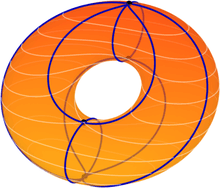Morse–Smale system
In dynamical systems theory, an area of pure mathematics, a Morse–Smale system is a smooth dynamical system whose non-wandering set consists of finitely many hyperbolic equilibrium points and hyperbolic periodic orbits and satisfying a transversality condition on the stable and unstable manifolds. Morse–Smale systems are structurally stable and form one of the simplest and best studied classes of smooth dynamical systems. They are named after Marston Morse, the creator of the Morse theory, and Stephen Smale, who emphasized their importance for smooth dynamics and algebraic topology.
Characterizations
By Peixoto's theorem, the vector field on 2D manifold is structurally stable if and only if this field is Morse-Smale.
Examples

Flow lines on an upright torus: the stable and unstable manifolds of the saddle points do not intersect transversely, so the height function does not satisfy the Morse-Smale condition.

Flow lines on a tilted torus: the height function satisfies the Morse-Smale condition.
- Any Morse function f on a compact Riemannian manifold M defines a gradient vector field. If one imposes the condition that the unstable and stable manifolds of the critical points intersect transversely, then the gradient vector field and the corresponding smooth flow form a Morse–Smale system. The finite set of critical points of f forms the non-wandering set, which consists entirely of fixed points.
- Gradient-like dynamical systems are particular case of Morse–Smale systems.
- For Morse–Smale systems on 2D-sphere all equilibrium points and periodical orbits are hyperbolic; there are no separatrice loops.
gollark: It is:- inevitable- inescapable- ineluctable
gollark: I see.
gollark: Fascinating.
gollark: This depends on whether there is a fourth spatial dimension.
gollark: I'm not saying it's entirely wrong, just mostly wrong.
References
- D. V. Anosov (2001) [1994], "Morse–Smale system", Encyclopedia of Mathematics, EMS Press
- Dr. Michael Shub (ed.). "Morse-Smale systems". Scholarpedia.
This article is issued from Wikipedia. The text is licensed under Creative Commons - Attribution - Sharealike. Additional terms may apply for the media files.